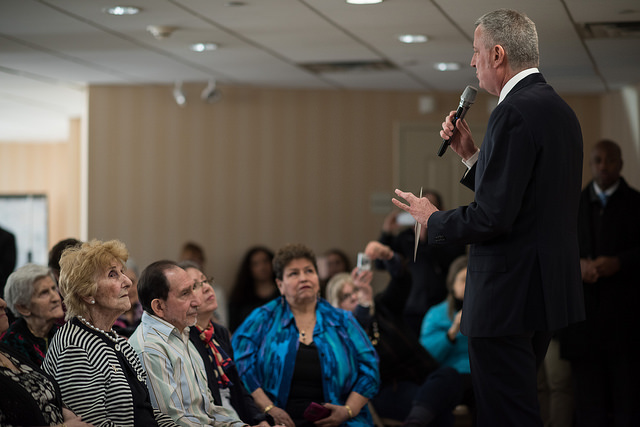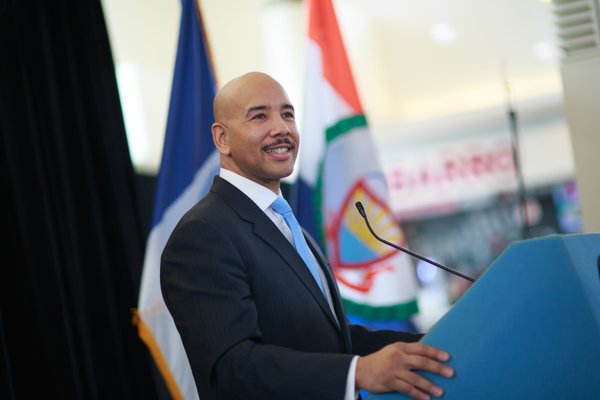The Mayor's Moment to Show His Commitment to Seniors

Mayor de Blasio speaks with seniors (photo: Michael Appleton/Mayor's Office)
As we age, we build momentum that is powering the economy, communities, and politics. Older people across the five boroughs are supporting local businesses, caring for their grandchildren, and participating in local politics. And yet we still find that many people aging into their later years cannot access this energy due to poverty, disability, and the lack of access to vital community services. We know almost one in three older New Yorkers struggles to make ends meet – living with painful, daily choices among food, medicine, and rent.
Over 40% report levels of disability and many older people struggle with social isolation, which research now tells us is a greater predictor of early death than obesity. Further, thanks to stagnant and antiquated city funding levels, over 800 are waiting since August for home care, while upwards of 2,000 are waiting for case management services that help people remain in their homes with modest assistance.
At first glance the issues seem overwhelming and unsolvable. But in fact, we already know what works and thankfully have an infrastructure here in New York to build upon. LiveOn NY represents a network of 100 member non-profit organizations that run roughly 800 programs in the five boroughs, including senior centers, meals on wheels, caregiver support, and case management. These programs provide critical community-based supports that together represent the foundation of an age-friendly city.
And this network of services is as diverse as our great city – providing assistance, classes, and programming that reflect every language, culture, nationality, and identity. Furthermore, we know that these services are not only culturally relevant and locally based but also efficient and effective. A recent New York City Department for the Aging study reports that seven in ten seniors attend their local senior center to avoid social isolation and over 20% found improved mental health through attendance. One out of four reported their physical health improved. These are important results and have incredible potential as people age into their seventies, eighties, and nineties.
So given the importance of these services in helping us age well and in our beloved communities, why is this network completely left out of the mayor’s budget priorities? Once again, we have an executive budget proposal from the mayor that shows a refusal to add any new funds to solve wait-lists or add capacity for future demand.
If Mayor de Blasio supports social justice and believes in progressivism, why does he leave out the later years of life? Are older New Yorkers exempt from social justice across the lifespan? And what about the daughter caring for her aging mother and her own children? She can count on universal pre-kindergarten for her young children yet nothing but waiting lists for her aging mother.
Mayor de Blasio ran on ending the tale of two cities. He recognized that the conditions in our wealthiest zip codes were only half of the story and that a truly progressive New York must create equitable opportunity for all. The chapters in that tale cannot end at age 60. We must ensure social justice across the lifespan. In addition to funding for the youngest and healthiest among us, the city budget must also include a robust plan that will support all of us as we age.
LiveOn NY, together with other advocates, has presented a $60 million budget plan to appropriately fund the city’s Department for the Aging. This needed support would begin to make the kind of investment in aging services that are needed. And beyond the budget, all of us must get involved in advocating for this inclusion. The foundation of aging services exists but needs serious additional investment in order to remain in place today and into the future.
Mayor de Blasio and the City Council have a choice - harness the momentum of later life by ensuring an equitable city budget or contribute to the tale of two cities. As New Yorkers, we pride ourselves on our ingenuity to develop solutions to challenging problems. We’ve often thought that the hidden secret of this city is the heart and willingness to work hard on behalf of our vulnerable neighbors. As we live longer, New Yorkers are seeking solutions to the challenges of aging and to the strong desire to remain engaged, involved citizens. Let’s lean in and move the momentum of older New Yorkers forward. Opportunities abound. But not without budgetary commitments to aging services.
***
Allison Nickerson is executive director and Bobbie Sackman is associate executive director of public policy for LiveOn NY. On Twitter @LiveOnNY.
***
Have an op-ed idea or submission for Gotham Gazette? Email This email address is being protected from spambots. You need JavaScript enabled to view it.
The Future of Latino Politics in New York City

Ruben Diaz Jr. (photo: @rubendiazjr)
Just last month the annual Somos El Futuro legislative conference took place in Albany. Over 30 years ago a group of Latino elected officials and community leaders initiated the conference as a means to highlight issues important to Latinos and to shine a light on the plight of Latinos in New York. The visionary leadership of these early pioneers was to capitalize on and give consciousness to the ever-growing presence of Latinos in the state. Perhaps the name itself, Somos El Futuro -- We are the Future -- was not only a testament of the current influence of the Latino presence in New York at the time but also an apt moniker of the eventual significance of this surging community.
In a recent column, I highlighted the growing Latino electoral presence in New York City. Latinos now make up almost a quarter of the entire city electorate. Based on sheer numbers Latinos can now claim that they are not just the future but that estamos aqui ahora -- we are here now.
With this increasing presence has come a steady growth in Latino political representation, even though gentrification poses a real threat to some Latino-majority districts. The rise of the Latino presence citywide produced some noteworthy political leaders that in fact became pioneers and leading figures in our community. Among them we can note the work of Tony Mendez, Oscar Garcia Rivera, Herman Badillo, Olga Mendez, Angelo Del Toro, and Jose Rivera (who continues to serve in office).
Without a doubt, these pioneers have paved the way for a newer crop of Latino political leaders, many of whom are doing excellent work in their respective communities. Many are not only providing pivotal leadership in their districts, some have the potential to be serious and credible candidates for citywide office in the near future. It’s important to also note that the extremely important work of providing leadership in Latino areas—communities often riddled with rampant poverty, decrepit housing, and overcrowded schools—is not only being provided by elected officials. In fact, there are a number of Latino community activists, many of them young, fighting ardently for the justice that Latinos demand and deserve.
The last time a Latino gained a top spot on a citywide ballot was Fernando Ferrer in 2005. Prior to that it was Badillo, whose 1977 mayoral candidacy gained the affection of Latinos in New York (he also ran two more times for mayor). It is my belief that for the 2021 elections, Latinos can once again have a Latino (possibly more than one) launching a credible campaign for citywide office. The question is, who might these candidates be that can gain the attention of not only Latinos but also a wider electorate and public? Who will be the next Ferrer or Badillo?
The first that has to be highlighted is Ruben Diaz, Jr., the current Bronx Borough President. Very recently, Diaz, Jr. was a constant name in the ever-present rumor mill regarding a potential challenge to Mayor de Blasio. Diaz, Jr. instead has decided to seek re-election. Over the years, he has taken credit for a boon in Bronx development projects (something which in fact began occurring during Ferrer’s tenure in the borough presidency) and has been a fierce advocate for the people in his borough. While lacking the intellectual heft of a Badillo and Ferrer, Diaz, Jr. has a magnetic personality that is sure to attract many as his final term as borough president nears an end.
There is also Melissa Mark-Viverito, the current speaker of the City Council. Her position has given her the most Latino clout in recent years to influence citywide policy, some of which she has used. This platform has provided Mark-Viverito an ample opportunity to garner broad attention and to push for policy issues pertinent to a wider public and also to Latinos in particular. However, since she is term-limited and likely will be out of the public eye on a consistent basis, her chances for a successful citywide race in four years will be virtually impossible.
One person to keep an eye on is Ritchie Torres, a Bronx City Council member. Elected in 2013, at the youthful age of 25, Torres has proven to be a solid legislator, championing important causes, and also fighting ardently for better housing conditions for public housing residents. Torres is charismatic, well liked by his peers, and whip-smart. He has the uncanny ability to probe and articulate complex policy matters. At 29 years of age, Torres will surely be one to watch for years to come and could be a formidable candidate for either Bronx borough president or the city’s public advocate if he chooses to aspire to either position.
When looking at the horizon of Latino political leaders, the future seems bright -- the three aforementioned names are not the only ones on the list. With the continuing rise of Latinos in the overall population and increased voting participation, it may be quite possible that New York City will soon have its first Latino mayor.
[Also by Eli Valentin: Latino Voters and the 2017 New York City Elections]
***
Eli Valentin is a Democratic consultant and pastor of the Iglesia Evangelica Bautista in New York City. He is a frequent political analyst on Univision, and has appeared on NY1’s “Inside City Hall.” On Twitter @EliValentinNY.
***
Have an op-ed idea or submission for Gotham Gazette? Email This email address is being protected from spambots. You need JavaScript enabled to view it.
The ‘Worst State for Doctors’ Has a Dangerous Pre-existing Condition

photo
Another year, and another report naming New York the “Worst State for Doctors.” Time and time again, our state ranks dead last as a place for physicians to practice.
The primary reason for the Empire State’s strained relationship with the medical profession is the staggering cost of medical liability insurance. New York has the highest per capita medical liability payouts in the country. These payouts are 35 times higher, per capita, than they are in the lowest state. Nearly 20 percent of all the medical liability payouts in the U.S. are paid in New York, more than all of the medical liability payouts for the entire Midwest.
These costs drive doctors out of our state and weaken New Yorkers’ access to care. Since 2003, 16 hospitals in New York City have closed. To keep their doors open, some of the state’s remaining hospitals have opted to “go naked,” and not carry any medical liability insurance at all.
While it is tempting to blame the insurers for this cost crisis, many medical liability insurers are operating at a loss. The real culprit for New York’s runaway medical insurance costs is New York’s broken liability laws – laws that are bought and paid for by the state’s powerful trial lawyer special interest lobby.
The trial lawyer’s dominance over state government has created a disturbingly one-sided legal environment. For example, New York has no standards for expert witnesses, leading to “junk science” in the courtroom. Worse, there is no timeline for disclosure of experts, which allows personal injury lawyers to mask the merits of their case prior to trial. If doctors and their counsel do not know if the expert testifying in court is a world-class surgeon or a disbarred hack, they cannot adequately assess the evidence against them. This often leads to quick settlements, and an easy payday for plaintiffs’ lawyers.
Another boon for New York’s trial lawyers at the expense of our medical professionals is the state’s interest on judgments: the rate is currently fixed at an astonishing 9 percent. For doctors and their lawyers, running up 9 percent in interest is a major deterrent to filing an appeal. Whether cases are appealed or settled, resulting costs get passed on to patients.
New York’s spiraling medical insurance costs are not only endured by doctors and patients, they are put on the back of the taxpayer. Each year the state subsidizes the medical liability system with hundreds of millions of dollars in a desperate attempt to keep our doctors practicing here.
Many of the costs incurred by New York’s broken liability system are indirect. With the looming threat of lawsuits, many doctors practice “defensive medicine,” ordering more tests than needed. While these costs are not direct, each unnecessary procedure significantly raises the price of medical care.
But the crisis in our state’s medical liability system is not just an issue of cost and access, it is also an issue that impacts the doctor-patient relationship. New York’s current liability climate is so adversarial that physicians are dissuaded from making any statements of sympathy or apology for fear it will be used against them in court. Such statements are not only humane, but they have shown to reduce the time it takes to resolve medical liability cases. Thirty-six states have passed laws exempting statements of apology as an admission of guilt and liability. Not surprisingly, New York is not one of those states.
If the plaintiffs’ lawyers continue to get their way, lawmakers in Albany may actually make the situation worse, instead of addressing the issues discussed above. At the behest of the trial lawyers lobby, legislators are considering extending the statute of limitations on filing a medical liability claim. Enacting this proposal would undoubtedly lead to more lawsuits and even higher medical liability insurance costs. New York cannot continue to reign in last place; the Legislature needs to reject proposals that force talented medical professionals out of our state and focus on fixing the crisis at hand.
***
Thomas Stebbins is executive director of the Lawsuit Reform Alliance of New York. On Twitter @ThomasStebbins and @LawsuitReformNY.
***
Have an op-ed idea or submission for Gotham Gazette? Email This email address is being protected from spambots. You need JavaScript enabled to view it.




